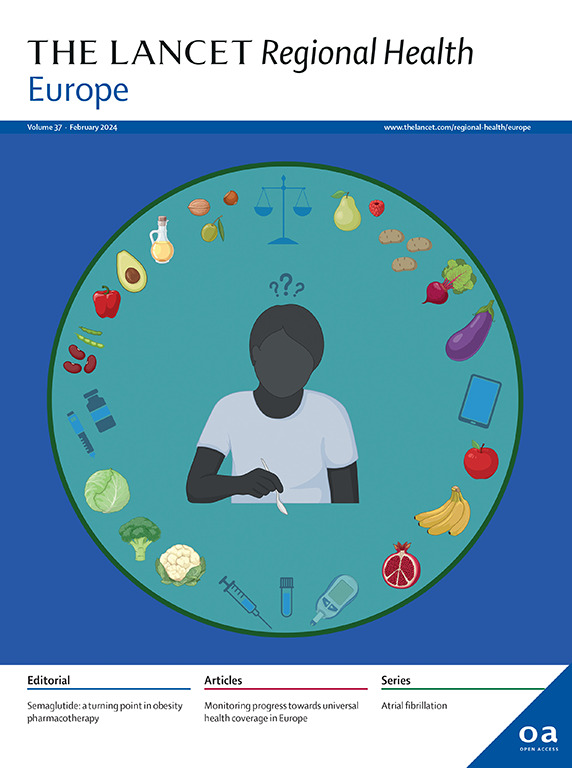巴塞罗那基线风险评分预测首次脱髓鞘事件后的长期预后:一项前瞻性观察研究
IF 13
Q1 HEALTH CARE SCIENCES & SERVICES
引用次数: 0
摘要
在多发性硬化症(MS)中,在症状发作时预测谁将发展为早期和严重的残疾是一个未满足的需求,具有重要的治疗意义。在这里,我们提出巴塞罗那基线风险评分(BRS)模型,以灵活和通用的方式预测长期疾病结果。方法使用巴塞罗那首次发作队列的前瞻性数据,我们创建了Barcelona- brs模型,作为一组6个威布尔生存模型,时间到扩展残疾状态量表评分为3.0,建立了灵活的预测因子组合,包括性别、首次发作年龄、T2病变的数量和地形等,可适应数据的可用性。通过Kaplan-Meier和混合效应模型,确定并比较数据驱动的风险组的长期临床和MRI结果,包括复发相关恶化(RAW)、独立于复发活动的进展(PIRA)、转化为继发性进展性MS (SPMS)、病变和脑容量数据以及患者报告/给药的临床评分。最后,我们在一个完全不可见的队列中外部验证了我们的模型。我们纳入了1074例首次脱髓鞘发作的患者(737例[69%]女性,平均年龄:31.7岁)。在中位11.9年的随访中,分别有375例(35%)、298例(28%)和94例(8.8%)发生RAW、PIRA和SPMS。Weibull模型包括首次发病年龄、脑T2病变数量和首次就诊时残疾作为主要预测因素。创建了四个数据驱动的不利结果风险增加的组:浅色-绿色- brs (N = 258),深绿色- brs (N = 319),橙色- brs (N = 321)和红色- brs (N = 176),随着时间的推移,它们在残疾,生活质量和MRI测量方面表现显着不同,红色- brs是结果最差的组(p <;0.01)。外部验证队列(N = 139,100名女性[72%],34岁)的结果与原始队列相同。解释:Barcelona-BRS模型的稳健性、灵活性和通用性支持其作为临床实践的现成工具的考虑。本文章由计算机程序翻译,如有差异,请以英文原文为准。
The Barcelona baseline risk score to predict long-term prognosis after a first demyelinating event: a prospective observational study
Background
In multiple sclerosis (MS), predicting at symptom onset who will develop early and severe disability is an unmet need with significant therapeutic implications. Here we propose the Barcelona-Baseline Risk Score (BRS) model to predict long-term disease outcomes in a flexible and generalisable manner.
Methods
Using prospectively acquired data from the Barcelona first-attack cohort, we created the Barcelona-BRS model as a set of six Weibull survival models of time to an Expanded Disability Status Scale score of 3.0, built with flexible combinations of predictors, including sex, age at first attack, and number and topography of T2 lesions, among others, adaptable to data availability. Data-driven risk groups were identified and compared in terms of long-term clinical and MRI outcomes, including relapse-associated worsening (RAW), progression independent of relapse activity (PIRA), conversion to secondary progressive MS (SPMS), lesional and brain volumetric data, and patient-reported/administered clinical scores, through Kaplan–Meier and mixed-effects models. Finally, we externally validated our model in a completely unseen cohort.
Findings
We included 1074 patients (737 [69%] female, mean age: 31.7 years) with a first demyelinating attack. Over a median follow-up of 11.9 years, 375 (35%), 298 (28%), and 94 (8.8%) developed RAW, PIRA, and SPMS, respectively. Weibull models included age at first attack, number of brain T2 lesions, and disability at first visit as main predictors. Four data-driven groups of increasing risk of unfavourable outcomes were created: Light-Green-BRS (N = 258), Dark-Green-BRS (N = 319), Orange-BRS (N = 321), and Red-BRS (N = 176), which, over time, behaved significantly differently across disability, quality of life, and MRI measures, being the Red-BRS the group with worst outcomes (p < 0.01). The results in the external validation cohort (N = 139, 100 female [72%], 34 years) mirrored those of the original one.
Interpretation
The robustness, flexibility, and generalisability of the Barcelona-BRS model support its consideration as a ready-to-use tool for clinical practice.
Funding
None.
求助全文
通过发布文献求助,成功后即可免费获取论文全文。
去求助
来源期刊

Lancet Regional Health-Europe
Multiple-
CiteScore
19.90
自引率
1.40%
发文量
260
审稿时长
9 weeks
期刊介绍:
The Lancet Regional Health – Europe, a gold open access journal, is part of The Lancet's global effort to promote healthcare quality and accessibility worldwide. It focuses on advancing clinical practice and health policy in the European region to enhance health outcomes. The journal publishes high-quality original research advocating changes in clinical practice and health policy. It also includes reviews, commentaries, and opinion pieces on regional health topics, such as infection and disease prevention, healthy aging, and reducing health disparities.
 求助内容:
求助内容: 应助结果提醒方式:
应助结果提醒方式:


